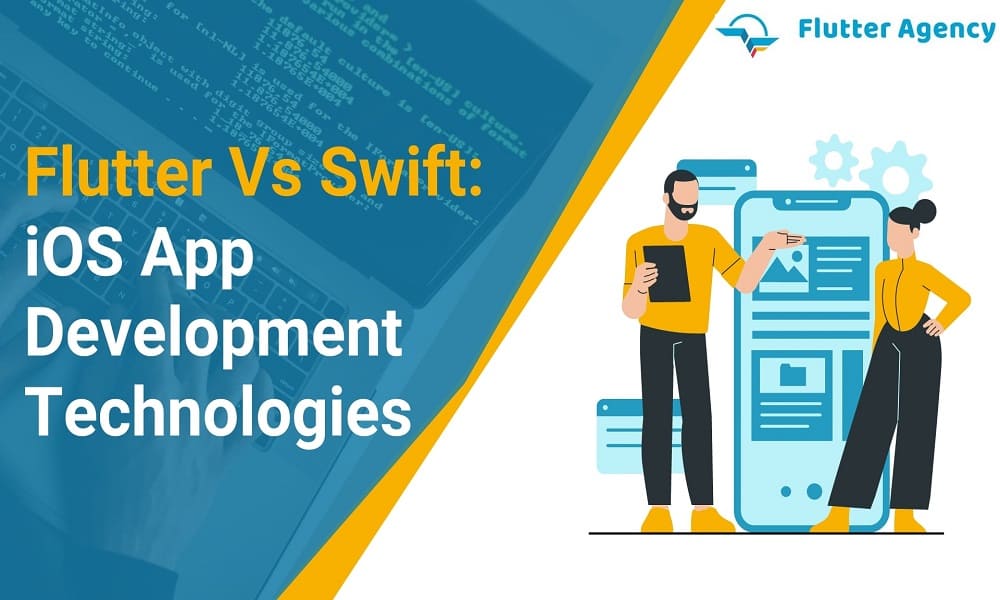Flutter vs Swift: Which One is Better for iOS Applications
Behind every successful application are the development approach, coding methods, and superior technology stack. A programming language used to code a business application is one of the highest milestones in supporting your enterprise mobile app development needs.
In iOS development, you should provide equal importance to an app’s performance, quality and the app store needs. A programming language in the tech stack will build the intuitive front end and flawless backend requirements if necessary.
Swift is the iOS programming language, whereas, Flutter is a UI toolkit integrated to devise smooth frontends. This blog will give information about the critical features of swift and Flutter. The comparative analysis of Flutter vs Swift helps you understand which will work and in what circumstances.
What is Swift?
Swift is a high-level programming language developed by the open-source community in partnership with Apple. It is the multi-paradigm, and this language works with both Cocoa and Cocoa Touch frameworks.
This technical language will extend its support to multiple functions, including dynamic dispatch, late binding and extensible programming. The newest version of the programming Swift 5.6 has numerous capabilities which can create unique applications.
This language is a replacement for Objective – C that helps to improve the developer’s productivity and will streamline the development.
Fundamental features for the Swift
The syntax is easy-to-use:
The syntax is well-known due to its ease of access and simplicity. You can code any logic or algorithm using more expressive and rational code with its programming language. It will make it easier for you to read via the code.
Superior Memory Management:
The previous versions of Swift and the other programming languages for iOS were well-known for using excess memory. It automatically sets the memory slot within the application, which makes it easy for an application to save some bandwidth and storage.
Impressive Generics:
It permits you to reuse the functions and handle the application flexibly.
Fast Performing:
It is the quicker-performing programming language. In this, you don’t require to invest time in testing code or correcting bugs or errors, as it will automate the procedure. Hence, you will save time working on the application.
Deliver on Multiple platforms:
This programming language is compatible with various operating systems, including Linux, WatchOS and macOS.
Improves the code security:
With Swift, you can build your apps secure and safe. The programming language will check the code before going into production. A base language will automatically erase the unsecured parts for runtime and release only safety aspects.
What is Flutter?
Flutter is an open-source UI framework invented by Google which helps in creating native applications by using a single codebase. You can get multi-platform apps using only one Flutter codebase.
It compromises the SDK with the tools needed to implement the application for iOS and Android. It has reusable and extensive UI elements, creating the interface quickly. This framework is built using the Dart programming language, has undergone various changes and still is improving.
With Flutter, you can not only design the applications but test and deploy them with ease.
Fundamental features of Flutter
Hot Reload:
It is one of the best features of this framework. It permits the programmers to change the live environment without impacting the production-stage development. Hence, it will speed up the error-finding process and deploy the changes.
The Widget library:
A UI element in Flutter is created as the widgets. Therefore, you can utilize these widgets to customize the application and incorporate them into your design. In this manner, it makes the complex structure appear to be simple.
Native-like Performance:
As a cross-platform framework, it provides a native-like appeal and performance. This framework also compromises the platform-specific widgets to implement some particular functionality and features. It uses native-specific coding languages via third-party integrations to incorporate the native components.
Open-Source:
You know entirely about the source code and can make the changes to the same to deploy specific framework updates.
Multi-platform development:
You can design applications for mobile and multiple web applications. For example Healthcare, Education, Finance and many more.
Differentiation between iOS and Swift for iOS
| Components | Swift | Flutter |
| App Launch | In this, you must develop every UI and UX element from scratch. Furthermore, if the company needs a multi-platform application, you must spend your resources and time creating the android application | With the separate codebase and inherent widgets, you can deliver the applications for Android and iOS simultaneously. It merges with the IDEs that provide applications’ smooth development and deployment |
| Plugins and Code Reusability | It permits to reuse of the functions within a similar logic for the coding. It didn’t allow the reusability of the code or plugin to design the applications for another platform | This framework is well-known for its code and plugin reusability. You can build the single codebase and run it across Windows, Linux, Android and other platforms |
| Speed | As it is the native language, it is assumed to be quicker. The key reason is that it builds with the native languages | The build time, also startup of Flutter is very low. It is generally cut-throat in speed with native languages |
| Performance | You can construct clean, fast, and reliable applications with Swift as it doesn’t compromise on quality or performance | It provides the native-like performance as it is more likely a native-coded language. Pre-set effects and animation packages will make it easier to create the native-like interface |
| Popularity in the market | Only 5% of the developers use Swift for programming their software solutions | Nowadays, in the technical market, Flutter is adopted by 90% of the developers for its software solutions |
| Native App Development | It is the native programming language devised for iOS. An Apple Community guides the elements and components | It is native-like multi-platform app development. It compromises the elements and widgets merged with native elements to offer native performance and appeal |
| User Interface | With this technical language, you can develop an iOS-specific interface. The UX elements will be native. Hence, it is easy to build interface elements with Swift. Though, you must create all the UI/UX elements from scratch | Flutter uses the widget system, which has a widget for every interface and element. You do not need the support of native programming languages, which will enable interface components. Hence, it looks like a native development |
| Build time | It permits the developer to code fast. It will usually take more time to find errors and bugs, reducing development time | Flutter allows you to create apps with UI widgets and tools quickly. However, with hot reload, you can add new features quickly. A Flutter syntax will enable users to write code with a few lines compared to native languages |
| Cost | Swift allows you to design apps for the only iOS platform. If you wish to develop the same app for the android device, then you need to use a different technical language and the team | It will authorize the expertise to develop an application for both iOS and Android simultaneously. Hence, you can use the individual codebase and the team to launch an app on multiple platforms |
| Testing | This technology uses Apple’s testing framework XCTest for the performance, unit and other app testing requirements. You can also perform a range of tests, including the application’s beta testing | Flutter assures that coding is simple, clean and readable from the beginning. It has an in-built testing framework that enables rapid and easy testing. If you wish to perform unit or load testing, this framework can work on it |
| Use Cases | It is used to develop various types of applications for many firms. You can create advanced and complicated logic with this language, and in the same manner, it is advanced for gaming apps too | It is sued to deliver complex applications across the business. It has the same limitations expressed by Dart and is not used for advanced gaming solutions |
Conclusion
We could deliver your dream mobile app using the best technology stack combined with the app design and its logic. As a leading and reputed Flutter app development company, we give you the best mobile app depending on your requirements. If you want to develop an application, hire our developers, which provide the right solutions for your needs.
Frequently Asked Questions (FAQs)
1. How to select a programming language for the needs of the app development?
When you opt for the technical language, consider some of the factors listed below:
- Development and execution speed of the syntax
- Accessibility and availability of developers
- Futuristic coding possibilities
- Reliability and robust
2. Why should you hire our Flutter developer?
Our dedicated Flutter developers will ensure consistent performance, from planning the timeline to designing and developing any complicated application in significantly less time than native app development.
3. What skills are needed for Flutter programmers before hiring them for a project?
They must have a basic understanding of agile development and also can write concise and well-documented code. A developer has to follow company guidelines and possess some basic social skills.
Contemporary ventures
Recent blog
ready to get started?
Fill out the form below and we will be in touch soon!
"*" indicates required fields













